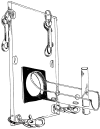Training rhesus macaques for venipuncture using positive reinforcement techniques: a comparison with chimpanzees
- PMID: 18210997
- PMCID: PMC2652623
Training rhesus macaques for venipuncture using positive reinforcement techniques: a comparison with chimpanzees
Abstract
As more emphasis is placed on enhancing the psychological well-being of nonhuman primates, many research facilities have started using positive reinforcement training (PRT) techniques to train primates to voluntarily participate in husbandry and research procedures. PRT increases the animal's control over its environment and desensitizes the animal to stressful stimuli. Blood draw is a common husbandry and research procedure that can be particularly stressful for nonhuman primate subjects. Although studies have demonstrated that chimpanzees can be trained for in-cage venipuncture using PRT only, fewer studies have demonstrated success using similar techniques to train macaques. It is often assumed that macaques cannot be trained in the same manner as apes. In this study, we compare PRT data from singly housed adult rhesus macaques (Macaca mulatta; n = 8) with data from group-housed adult chimpanzees (Pan troglodytes; n = 4). All subjects were trained to place an arm in a 'blood sleeve' and remain stationary for venipuncture. Both facilities used similar PRT techniques. We were able to obtain repeated blood samples from 75% of the macaques and all of the chimpanzees. The training time did not differ significantly between the 2 species. These data demonstrate that macaques can be trained for venipuncture in a manner similar to that used for chimpanzees.
Figures




Similar articles
-
Factors affecting initial training success of blood glucose testing in captive chimpanzees (Pan troglodytes).Zoo Biol. 2014 May-Jun;33(3):212-20. doi: 10.1002/zoo.21123. Epub 2014 Apr 3. Zoo Biol. 2014. PMID: 24706518 Free PMC article.
-
Positive reinforcement training as a technique to alter nonhuman primate behavior: quantitative assessments of effectiveness.J Appl Anim Welf Sci. 2003;6(3):175-87. doi: 10.1207/S15327604JAWS0603_03. J Appl Anim Welf Sci. 2003. PMID: 14612266 Review.
-
Effective chair training methods for neuroscience research involving rhesus macaques (Macaca mulatta).J Neurosci Methods. 2019 Apr 1;317:82-93. doi: 10.1016/j.jneumeth.2019.02.001. Epub 2019 Feb 6. J Neurosci Methods. 2019. PMID: 30738106 Free PMC article.
-
Refining the pole-and-collar method of restraint: emphasizing the use of positive training techniques with rhesus macaques (Macaca mulatta).J Am Assoc Lab Anim Sci. 2014 Jan;53(1):61-8. J Am Assoc Lab Anim Sci. 2014. PMID: 24411781 Free PMC article.
-
Behavioral management of chimpanzees in biomedical research facilities: the state of the science.ILAR J. 2005;46(2):192-201. doi: 10.1093/ilar.46.2.192. ILAR J. 2005. PMID: 15775028 Review.
Cited by
-
Refinements in Clinical and Behavioral Management for Macaques on Infectious Disease Protocols.Vet Sci. 2024 Oct 1;11(10):460. doi: 10.3390/vetsci11100460. Vet Sci. 2024. PMID: 39453052 Free PMC article. Review.
-
Refinements to captive chimpanzee (Pan troglodytes) care: a self-medication Paradigm.Anim Welf. 2018 Nov;27(4):327-341. doi: 10.7120/09627286.27.4.327. Anim Welf. 2018. PMID: 31244511 Free PMC article.
-
Improved Training and Semen Collection Outcomes Using the Closed Box Chair for Macaques.Animals (Basel). 2021 Aug 12;11(8):2384. doi: 10.3390/ani11082384. Animals (Basel). 2021. PMID: 34438841 Free PMC article.
-
Creative implementation of 3Rs principles within industry programs: beyond regulations and guidelines.J Am Assoc Lab Anim Sci. 2015 Mar;54(2):133-8. J Am Assoc Lab Anim Sci. 2015. PMID: 25836958 Free PMC article.
-
Factors affecting initial training success of blood glucose testing in captive chimpanzees (Pan troglodytes).Zoo Biol. 2014 May-Jun;33(3):212-20. doi: 10.1002/zoo.21123. Epub 2014 Apr 3. Zoo Biol. 2014. PMID: 24706518 Free PMC article.
References
-
- Bloomsmith MA, Else JG. 2005. Behavioral management of chimpanzees in biomedical research facilities: the state of the science. ILAR J 46:192–201 - PubMed
-
- Capitanio JP, Kyes RC, Fairbanks LA. 2006. Considerations in the selection and conditioning of Old World monkeys for laboratory research: animals from domestic sources. ILAR J 47:294–306 - PubMed
-
- Clarke AS, Mason WA, Moberg GP. 1988. Interspecific contrasts in responses of macaques to transport cage training. Lab Anim Sci 38:305–309 - PubMed
-
- Coleman K, McMillan JL, Tully LA, Maier A. 2005. Establishing a training program for nonhuman primates, p 77–93. In Puri CP, Ganguly NK. National Center for Primate Breeding and Research: vision, challenges, and opportunities. Mumbai (India): National Institute for Research in Reproductive Health
-
- Coleman K, Tully LA, McMillan JL. 2005. Temperament correlates with training success in adult rhesus macaques. Am J Primatol 65:63–71 - PubMed
Publication types
MeSH terms
Grants and funding
LinkOut - more resources
Full Text Sources
Research Materials
